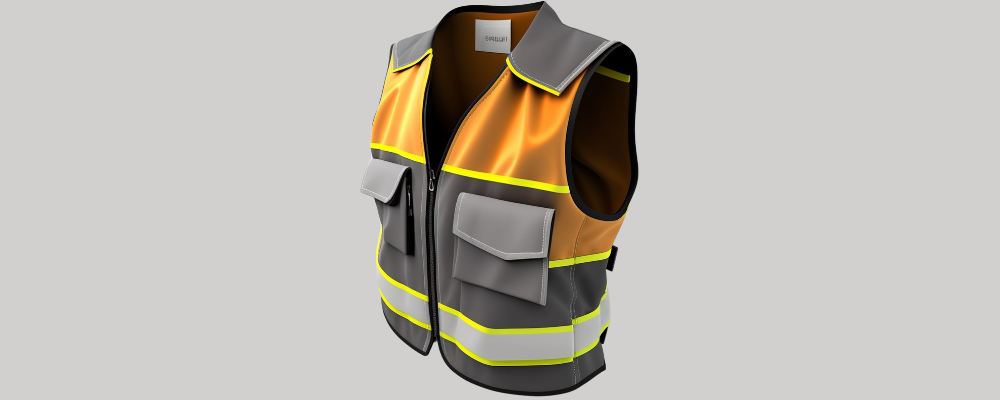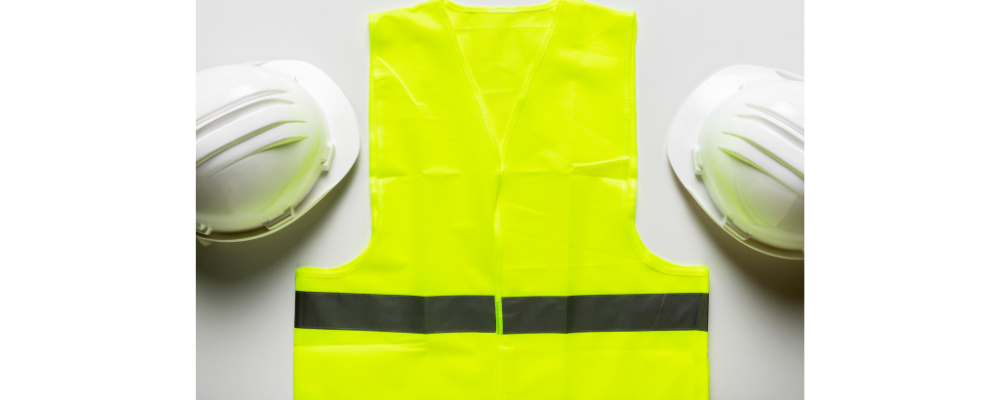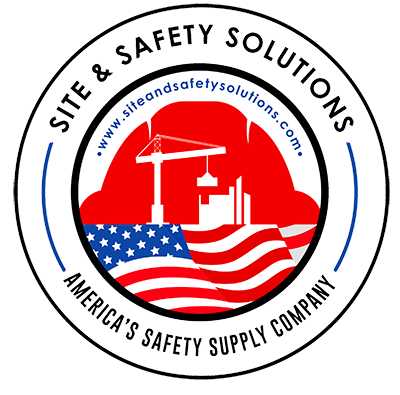
Introduction
In today’s fast-paced work environments, ensuring the safety of employees is paramount. Safety vests enhance workplace safety by increasing visibility and awareness, particularly in high-risk industries such as construction, roadwork, and manufacturing. At Site and Safety Solutions, we understand the importance of reliable safety gear, so we offer a diverse range of safety vests designed to meet various industry needs.
Understanding Safety Vests
In workplace safety, safety vests are one of the most essential pieces of personal protective equipment (PPE). This chapter delves into the fundamental aspects of thes vests, highlighting their significance, legal implications, and the various types available to cater to different safety needs.
What are Safety Vests?
Safety vests, often referred to as high-visibility vests or reflective vests, are garments designed to enhance the visibility of workers in hazardous environments. They are typically made of fluorescent materials such as polyester or mesh fabrics, incorporating reflective tapes or strips to improve visibility during low-light conditions or in environments with poor visibility. The distinctive color and nostalgic elements of safety vests make wearers more conspicuous to others, reducing the risk of accidents, particularly in high-traffic areas or construction sites.
Importance of Safety Vests in the Workplace
These vests play a pivotal role in mitigating workplace accidents and injuries, primarily by increasing the visibility of workers to others, including vehicle operators, machinery operators, and fellow workers. By enhancing visibility, safety vests help prevent collisions, struck-by accidents, and other hazardous incidents, thereby safeguarding the well-being of employees. Moreover, safety vests promote a culture of safety within the workplace, emphasizing the importance of PPE compliance and risk awareness among workers and employers alike.
Legal Requirements and Standards for Safety Vests
Governmental agencies and industry standards often regulate the utilization of safety vests to ensure adequate worker protection. In many countries, including the United States, safety vest requirements are codified under occupational safety and health regulations. For instance, the Occupational Safety and Health Administration (OSHA) mandates using high-visibility safety apparel in specific work environments, particularly construction, road work, and utility maintenance.
Furthermore, these vests are subject to specific standards established by organizations such as the American National Standards Institute (ANSI). ANSI standards categorize safety vests into different classes based on their visibility levels and design features. Compliance with ANSI standards ensures that safety vests meet minimum requirements for visibility, color, and reflective properties, enhancing their effectiveness in safeguarding workers.
Different Types of Safety Vests (ANSI Class 1, 2, and 3)
Safety vests are classified into different types or classes based on design, visibility, and intended applications. The ANSI/ISEA (American National Standards Institute/International Safety Equipment Association) standards outline three primary classes of safety vests:
- Class 1 Safety Vests: These vests provide the lowest level of visibility enhancement and are suitable for environments with minimal risks, such as parking lots, warehouses, and sidewalk maintenance.
- Class 2 Safety Vests: Offering moderate visibility enhancement, Class 2 vests are recommended for workers in higher-risk environments, including construction sites, roadways, and traffic control zones.
- Class 3 Safety Vests: Designed for maximum visibility, Class 3 vests are intended for workers in high-risk environments with critical visibility, such as highway construction zones, emergency response scenes, and complex work environments with fast-moving traffic.
Specific design features, including the amount of fluorescent background material, the width and configuration of reflective strips, and additional elements, such as sleeves or harnesses, characterize each safety vest class. By selecting safety vests according to ANSI class specifications, employers can ensure that workers receive appropriate protection tailored to the hazards of their work environments.
Understanding the intricacies of these vests, including their purpose, regulatory requirements, and classification standards, is essential for promoting workplace safety and mitigating occupational risks. In the subsequent chapters, we will explore the features, benefits, and best practices associated with different types of safety vests offered by Site and Safety Solutions, empowering employers and workers alike to make informed decisions regarding their safety gear.

Features and Benefits of Safety Vests
Safety vests are essential gear in industries where visibility is crucial for worker safety. Understanding the features and benefits of these vests is key to selecting the right ones for your workplace needs. This chapter will delve into four critical aspects of safety vests: high visibility, reflective materials, durability and comfort, and weather resistance.
-
High Visibility: How Safety Vests Improve Visibility in Various Conditions
Safety vests are designed with high-visibility colors such as fluorescent yellow, orange, or green, making wearers easily noticeable in various work environments. These bright colors stand out against most backgrounds, enhancing visibility during daylight hours. In situations with reduced visibility due to fog, rain, or other adverse weather conditions, high-visibility colors ensure that workers remain conspicuous in their surroundings, reducing the risk of accidents.
The fluorescent fabric used in safety vests absorbs ultraviolet (UV) light during the day and emits it at a longer wavelength, making the vests appear exceptionally bright. This phenomenon, known as fluorescence, enhances visibility even in low-light conditions. Additionally, some safety vests feature contrasting colors or reflective strips to increase visibility, especially in complex work environments where workers may be surrounded by moving machinery or vehicles.
-
Reflective Materials: Enhancing Nighttime Visibility
Reflective materials, typically in strips or patches, play a crucial role in enhancing nighttime visibility. When illuminated by headlights or other light sources, these materials reflect light towards its source, making the wearer highly visible in the dark. Reflective materials are strategically placed on safety vests to create contrast and attract attention, ensuring that workers remain visible to drivers and equipment operators, thereby reducing the risk of accidents.
The effectiveness of reflective materials depends on their quality and placement on the safety vest. ANSI/ISEA standards specify minimum requirements for the amount and placement of reflective materials based on the safety vest class, ensuring optimal visibility in various work environments and lighting conditions.
-
Durability and Comfort: Factors to Consider When Choosing Safety Vests
These vests are subjected to harsh working conditions, including exposure to UV radiation, abrasion, and frequent washing. Therefore, durability is a critical factor to consider when selecting safety vests. High-quality safety vests are constructed from durable materials such as polyester or mesh fabric, which can withstand prolonged use without compromising visibility or comfort.
Comfort is equally important, as workers may need to wear safety vests for extended shifts. Breathable mesh panels, adjustable straps, and lightweight construction contribute to wearer comfort, allowing workers to focus on tasks without distractions. Additionally, ergonomic design features such as multiple pockets and tool loops enhance functionality while ensuring that essential items are easily accessible.
-
Weather Resistance: Importance of Weatherproof Safety Vests
Weatherproof vests are designed to withstand various weather conditions, including rain, wind, and cold temperatures. Waterproof and water-resistant coatings prevent moisture from penetrating the fabric, keeping workers dry and comfortable during inclement weather. Additionally, insulated safety vests provide added warmth in cold environments, ensuring workers remain protected and productive throughout their shifts.
Weatherproof safety vests often feature sealed seams, storm flaps, and adjustable cuffs to prevent water ingress and maintain wearer comfort. Breathable materials and ventilation panels allow moisture vapor to escape, preventing overheating and moisture buildup inside the vest. By investing in weatherproof vests, employers can ensure that their workers are adequately protected in all weather conditions, minimizing the risk of weather-related accidents and illnesses.
In conclusion, these vests with high visibility, reflective materials, durability and comfort, and weather resistance are essential for ensuring worker safety in various industries. By understanding these features and benefits, employers can select the most suitable safety vests for their workplace needs, reducing the risk of accidents and promoting a safe and productive work environment.
Exploring Our Safety Vest Collection
-
Band Hi-Vis Vest Yellow
Features:
- High-visibility yellow fabric with reflective bands for enhanced visibility in low-light conditions.
- Made from durable and lightweight materials for extended wear.
- Front closure with hook-and-loop or zipper for easy wear and removal.
- Available in various sizes to accommodate different body types.
- Compliant with ANSI/ISEA Class 2 standards for high-visibility safety apparel.
Benefits:
- Improved visibility: The bright yellow color combined with reflective bands ensures that wearers remain visible in daylight and low-light situations, reducing the risk of accidents.
- Comfortable to wear: Constructed from lightweight and breathable materials, the vest provides comfort during extended wear, making it suitable for all-day use.
- Easy identification: The vibrant yellow color makes it easy for colleagues and supervisors to identify workers in crowded or busy environments.
- Enhanced safety compliance: Meets ANSI/ISEA Class 2 standards, ensuring wearers comply with safety regulations.
Ideal Applications:
- Road construction and maintenance
- Traffic control
- Airport ground operations
- Landscaping and outdoor maintenance
-
Alabama Mesh Vest Yellow
Features:
- Mesh fabric construction for increased breathability and comfort in warm weather conditions.
- High-visibility yellow color with reflective strips for optimal visibility in various lighting conditions.
- Front closure options include hook-and-loop or zipper for easy wear and removal.
- Multiple pockets for convenient storage of small tools and equipment.
- ANSI/ISEA Class 2 compliant for high-visibility safety apparel.
Benefits:
- Enhanced comfort: The mesh fabric allows airflow, keeping the wearer cool and comfortable even in hot weather conditions.
- Improved visibility: Reflective strips ensure visibility in low-light environments, increasing safety on the job site.
- Versatile storage: Multiple pockets provide ample space for storing essential tools and personal items, promoting efficiency and productivity.
- Compliance assurance: Meets ANSI/ISEA Class 2 standards, ensuring adherence to safety regulations.
Ideal Applications:
- Construction sites
- Warehouse and distribution centers
- Landscaping and grounds maintenance
- Utility and telecommunications work
-
TruForce™ Class 2 Surveyor’s Safety Vest
Features:
- Explicitly designed for surveyors with specialized pockets and compartments for surveying equipment.
- High-visibility fluorescent color with reflective strips for maximum visibility in all lighting conditions.
- Durable and rugged construction to withstand the rigors of outdoor work environments.
- Front closure options include zipper or hook-and-loop for a secure fit.
- ANSI/ISEA Class 2 compliant for high-visibility safety apparel.
Benefits:
- Specialized design: Equipped with pockets and compartments tailored for surveying tools, ensuring convenience and efficiency for surveyors.
- Enhanced visibility: Fluorescent color and reflective strips improve visibility, increasing safety on surveying sites, especially in high-traffic areas.
- Durability: Constructed from durable materials, the vest withstands rough conditions, providing long-lasting protection and utility.
- Compliance assurance: Meets ANSI/ISEA Class 2 standards, ensuring compliance with safety regulations.
Ideal Applications:
- Land Surveying
- Civil engineering projects
- Construction sites with surveying activities
-
VIZ-PRO 5PT Break Away VEST (Orange)
Features:
- Breakaway design with quick-release buckles for easy removal in emergencies.
- Bright orange color for high visibility, with reflective strips for safety in low-light conditions.
- Made from tear-resistant and durable materials for long-term use.
- Adjustable straps for a customizable and comfortable fit.
- ANSI/ISEA Class 2 compliant for high-visibility safety apparel.
Benefits:
- Enhanced safety: Breakaway design reduces the risk of injury by allowing for quick removal in emergencies, such as entanglement with machinery.
- Optimal visibility: Bright orange color and reflective strips ensure visibility in various lighting conditions, improving safety on the job site.
- Durability: Tear-resistant materials ensure the vest withstands the demands of rigorous work environments, providing reliable protection over time.
- Adjustable fit: Adjustable straps allow for a customized and comfortable fit for wearers of various body types.
Ideal Applications:
- Utility and electrical work
- Manufacturing facilities
- Roadside maintenance and repair
- Industrial settings with machinery hazards

Choosing the Right Safety Vest for Your Needs
Assessing Workplace Hazards:
- Identify potential hazards in the work environment, such as low visibility, moving machinery, or traffic.
- Evaluate the level of risk associated with each hazard to determine the appropriate class of safety vest required.
Understanding ANSI Classifications:
- Familiarize yourself with ANSI/ISEA standards for high-visibility safety apparel (HVSA), including Class 1, Class 2, and Class 3.
- Choose safety vests that meet the ANSI classification requirements relevant to your workplace hazards and visibility needs.
Customization Options for Safety Vests:
- Consider customization options such as adding company logos, employee names, or specific color preferences to enhance brand visibility and employee recognition.
- Work with suppliers who offer customization services to create personalized safety vests tailored to your organization’s needs.
Sizing and Fit Guidelines:
- Take accurate measurements of employees to ensure proper sizing and fit of safety vests.
- Consider adjustable features such as straps or elastic sides to accommodate varying body shapes and sizes.
- Provide employees with guidance on adequately wearing and adjusting safety vests for maximum comfort and effectiveness.
Best Practices for Safety Vest Usage
Proper Maintenance and Care:
- Regularly inspect these vests for signs of wear and tear, including fraying seams, faded reflective materials, or damaged closures.
- Follow the manufacturer’s instructions for washing and maintenance to ensure the longevity and effectiveness of safety vests.
- Replace worn or damaged safety vests promptly to maintain optimal visibility and worker protection.
Employee Training and Awareness:
- Provide comprehensive training to employees on the importance of wearing safety vests and how to properly use and maintain them.
- Emphasize the role of safety vests in preventing accidents and injuries in the workplace.
- Encourage a culture of safety awareness among employees by promoting safety vests as part of daily routines.
Integrating Safety Vests into Safety Protocols:
- Incorporate safety vest requirements into existing safety protocols and procedures, such as job hazard analyses (JHAs) and safety training programs.
- Ensure supervisors and managers enforce safety vest policies consistently and lead by example in wearing safety vests on the job site.
For more information, visit our website and Facebook page.
For more products, visit our website :
TruForce™ Class 2 Surveyor’s Safety Vest
VIZ-PRO 5PT Break Away VEST (Orange)
Conclusion
Investing in high-quality safety vests is a legal requirement and a crucial step toward prioritizing employee safety. At Site and Safety Solutions, we provide top-notch safety gear that ensures maximum visibility, comfort, and protection for workers in various industries. Explore our extensive collection of safety vests today and take the first step towards a safer workplace environment.









